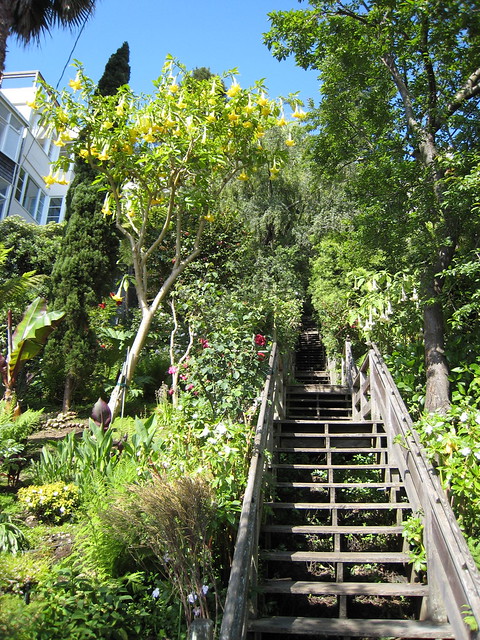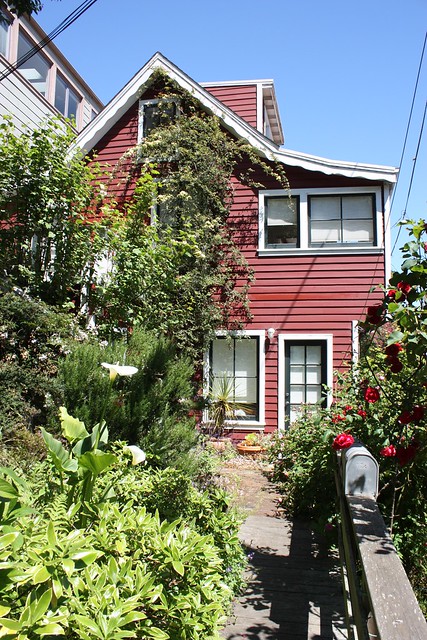This will be my last San Francisco post for the foreseeable future. I am aware that there are other neighborhoods in the city which fulfill the criteria I'm interested in, such as the Haight, but it's always seemed a bit out there for me, set apart from downtown by a few not so great neighborhoods.
Telegraph Hill is the most northeasterly residential neighborhood in San Francisco, visible for miles around thanks to Coit Tower at the peak of the hill. By the same architects who designed city hall, the tower was built in 1933 to commemorate the firemen of the city. Originally an Irish neighborhood in the 19th century, in the 1920's it became a magnet for bohemians and intellectuals. Though long gone, the neighborhood's namesake is a signalling semaphore built in 1849 to alert businessmen in the city of approaching ships and their cargo. The nearby port was supplied with stone ballast quarried from the hill, the result of which is a steep cliff on the east side of the hill. A landslide in 2007 forced the evacuation of many residents. Telegraph Hill is bounded by Broadway on its south edge, Sansome east, Bay north, and Stockton and Columbus west. There's a bit of overlap with North Beach on the western border, resulting in a diversity of commercial uses on Stockton Street and around Washington Square, but in general this is a residential neighborhood.

 |
| Telegraph Hill 1866. Image Library of Congress |
 |
| 1885. Image San Francisco Public Library |
 |
| Looking towards the financial district from corner of Vallejo and Kearny |
 |
| Kearny |
 |
| At the top of Kearny, closer to the summit, the home centre-left is on the market for $2.8 million |
 |
| Corner of Green and Kearny |
 |
| Looking down Montgomery at the corner with Green |
 |
| As an older neighborhood, Telegraph Hill has many narrow streets passing between blocks, like Castle Street here |
 |
| Sonoma |
 |
| Pfeiffer |
 |
| Bellair |
 |
| Child |
 |
| Telegraph Place in the shadow of the hill |
 |
| A bit of Chinatown creeping in on Grant Avenue, which cuts through the neighborhood north to south |
 |
| Further north, Grant narrows and becomes residential |
 |
| Grant is on the left of the image, top to bottom |
 |
| Union Street |
 |
| Modern shingle-clad apartments on Union |
 |
| Calhoun Terrace at the end of Union. The home just behind the bushes is the most expensive currently on the market in Telegraph Hill, at $11 million for 6800 sq ft |
 |
| Filbert on the corner with Stockton, with the Coit Tower visible behind |
 |
| Very pleasant streetscape here on Filbert |
 |
| Filbert at the intersection with Grant |
 |
| From the top of Filbert, Russian Hill visible beyond |
 |
| Greenwich at the corner with Grant |
 |
| Lombard, not quite as spectacular here as in Russian Hill |
 |
| Lombard turns into Telegraph Hill Boulevard, winding up the hill toward Coit Tower. This is the view westward from the Boulevard |
 |
| Chestnut |
 |
| At its eastern point, Chestnut turns south into a cul-de-sac with a few homes tucked away |
 |
| Francisco Street, essentially the most northern street in the neighborhood |
 |
| Montgomery at the corner with Union, "entrance" into my favorite streets in Telegraph Hill |
 |
| This is the most historical part of the neighborhood, with tight car access and plenty of pedestrian paths |
 |
| Filbert Street Steps, site of the Grace Merchant Gardens |
The area that is now the Filbert Street Steps was transformed from a landfill into a beautiful garden by Grace Merchant over a period of 30 years from 1949. Today, the steps offer access up and down the hill as well as the only path to the many 19th century houses, once the homes of immigrant fishermen and dock workers. Today they are among the most sought after in the city and rarely come up for sale, though one small 1884 cottage is currently available for $1.3 million.
 |
| Clinging to the hillside with no car access, it must be quite an effort to get home to the furthest homes |
 |
| Alta Street just off Montgomery has some ugly new buildings but also very historical homes |
 |
| Built in 1852, 31 Alta Street is on the market for $3.8 million |
 |
| Alta in the 19th century, when the home still had views which didn't include apartment buildings |
 |
| The street post-WWII |
 |
| Montgomery |
 |
| View down Montgomery |
Mercifully, Telegraph Hill is free of the overhead wires which plague some San Francisco neighborhoods. Combine that with some undoubtedly quirky well-maintained historical streets and you have a neighborhood with serious charm. Another thing the neighborhood shows is the very real difference greenery makes in a city. The contrast between streets with trees and bushes and those without is vast. The homes along Montgomery and along the hillside in particular are intriguing and are surely the least accessible by car in the city, not at all a bad thing. For those who grew up in a city with easily accessible public transport a short walk away, a life without a car is not only understandable, but sometimes desirable. This is a prospect many Americans don't understand, but one they'll have to become comfortable with if American cities are ever to once again be enjoyable places to live where a car is not a necessity.
I think San Francisco has shown us some of the best urban America has to offer, being the second most densely populated city in the country after New York. But while most urban cities in the country have a distinctly "northern" flavor about them, San Francisco shows us urbanism California style, with stunning views to boot. Paired with its unique architecture, San Francisco's neighborhoods have a unrepeatable atmosphere not found anywhere else. Honestly, I don't understand why many other cities in the Bay area are equally popular. If I lived anywhere near there, it'd be San Francisco for me. Forget suburban Palo Alto or Oakland.
Next up, I'm moving to Baltimore, the city which arguably introduced me to American urbanism beyond just Manhattan.
 |
| Filbert Street Steps among Grace Merchant Gardens. flickr : rich_4711 |




































































